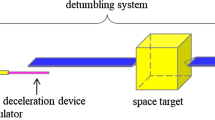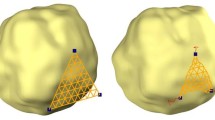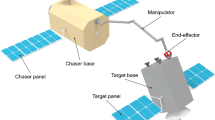Abstract
Malfunctioning satellites are normally in tumbling state due to residual angular momentum, rendering direct capture impossible. Therefore, detumbling these objects is an indispensable phase for on-orbit safe capture. A novel detumbling method, using a flexible device (e.g., brush or rod) to approach and compliantly contact the target objects, has been proposed to successfully avoid the major drawback of potential risky collisions. Although efficient, the flexible-device-based method suffers from two limitations: (i) Due to complex three-axis rotary motion, it is extremely difficult to predetermine the contact position on the target satellite so as to ensure simultaneous suppression of rotation and nutation. (ii) The conventional finite-element-based dynamic model of the large-deformation device is high-dimensional, causing unacceptable computing time for the on-orbit task. To address these problems, this paper proposes an optimal nutation suppressing method to ensure the most efficient suppression of nutation during detumbling. In addition, a highly efficient data-driven model is proposed to accurately describe the large-deformation flexible device for real-time on-orbit computation. Finally, numerical simulations are carried out to verify the feasibility and efficiency of the present method.















Similar content being viewed by others
Data availability
Data sharing is not applicable to this article as no datasets were generated or analyzed during the current study.
References
Forshaw, J.L., Aglietti, G.S., Fellowes, S., Salmon, T., Retat, I., Hall, A., et al.: The active space debris removal mission RemoveDebris. part 1: from concept to launch. Acta Astronautica. 168, 293–309 (2020). https://doi.org/10.1016/j.actaastro.2019.09.002
European Space Agency.: ESA’s Space Environment Report (2022). https://www.esa.int/Safety_Security/Space_Debris/ESA_s_Space_Environment_Report_2022
Georg, K., Michael, S., Peiyuan, W., Franz, K., Jiri, S., Thomas, S., et al.: Determination of attitude and attitude motion of space debris using laser ranging and single-photon light curve data. In: Flohrer, T., Schmitz, F., (eds.) 7th European Conference on Space Debris. Darmstadt, Germany: ESA Space Debris Office; Available from: https://conference.sdo.esoc.esa.int/proceedings/sdc7/paper/696 (2017)
Huang, W., He, D., Li, Y., Zhang, D., Zou, H., Liu, H., et al.: Nonlinear dynamic modeling of a tether-net system for space debris capture. Nonlinear Dyn. (2022). https://doi.org/10.1007/s11071-022-07718-7
Aglietti, G.S., Taylor, B., Fellowes, S., Salmon, T., Retat, I., Hall, A., et al.: The active space debris removal mission RemoveDebris. Part 2: in orbit operations. Acta Astronautica. 168, 310–322 (2020). https://doi.org/10.1016/j.actaastro.2019.09.001
Flores-Abad, A., Ma, O., Pham, K., Ulrich, S.: A review of space robotics technologies for on-orbit servicing. Progress Aerosp. Sci. 68, 1–26 (2014). https://doi.org/10.1016/j.paerosci.2014.03.002
Chen, G., Wang, Y., Wang, Y., Liang, J., Zhang, L., Pan, G.: Detumbling strategy based on friction control of dual-arm space robot for capturing tumbling target. Chin. J. Aeronaut. 33(3), 1093–1106 (2020). https://doi.org/10.1016/j.cja.2019.04.019
Abrishami, A., Gong, S.: Optimized control allocation of an articulated overactuated solar sail. J. Guid. Control Dyn. 43(12), 2321–2332 (2020). https://doi.org/10.2514/1.G005227
Papushev, P., Karavaev, Y., Mishina, M.: Investigations of the evolution of optical characteristics and dynamics of proper rotation of uncontrolled geostationary artificial satellites. Adv. Space Res. 43(9), 1416–1422 (2009). https://doi.org/10.1016/j.asr.2009.02.007
Gómez, N.O., Walker, S.J.I.: Earth’s gravity gradient and eddy currents effects on the rotational dynamics of space debris objects: Envisat case study. Adv. Space Res. 56(3), 494–508 (2015). https://doi.org/10.1016/j.asr.2014.12.031
Šilha, J., Pittet, J.N., Hamara, M., Schildknecht, T.: Apparent rotation properties of space debris extracted from photometric measurements. Adv. Space Res. 61(3), 844–861 (2018). https://doi.org/10.1016/j.asr.2017.10.048
Liu, Y., Liu, X., Cai, G., Xu, F., Tang, S.: Detumbling a non-cooperative tumbling target using a low-thrust device. AIAA J. 60(5), 2718–2729 (2022). https://doi.org/10.2514/1.J060982
Aslanov, V., Ledkov, A.: Detumbling of axisymmetric space debris during transportation by ion beam shepherd in 3D case. Adv. Space Res. 69(1), 570–580 (2022). https://doi.org/10.1016/j.asr.2021.10.002
Shan, M., Guo, J., Gill, E.: Review and comparison of active space debris capturing and removal methods. Progress Aerosp. Sci. 80, 18–32 (2016). https://doi.org/10.1016/j.paerosci.2015.11.001
Nakajima, Y., Mitani, S., Tani, H., Murakami, N., Yamamoto, T., Yamanaka, K.: Detumbling space debris via thruster plume impingement. In: AIAA/AAS Astrodynamics Specialist Conference. Long Beach, California: American Institute of Aeronautics and Astronautics; (2016)
Nakajima, Y., Tani, H., Yamamoto, T., Murakami, N., Mitani, S., Yamanaka, K.: Contactless space debris detumbling: a database approach based on computational fluid dynamics. J. Guid. Control Dyn. 41(9), 1906–1918 (2018). https://doi.org/10.2514/1.G003451
Dai, H., Zhao, H., Yue, X.: Plasma detumbling of failed spacecraft by using hall effect thrusters. J. Guid. Control Dyn. 45(12), 2389–2397 (2022)
Ortiz Gómez, N., Walker, S.J.I.: Eddy currents applied to de-tumbling of space debris: analysis and validation of approximate proposed methods. Acta Astronautica. 114, 34–53 (2015). https://doi.org/10.1016/j.actaastro.2015.04.012
Gómez, N.O., Walker, S.J.I.: Guidance, navigation, and control for the eddy brake method. J. Guid. Control Dyn. 40(1), 52–68 (2016). https://doi.org/10.2514/1.G002081
Li, M., Zhang, Y., Zhang, J., Lin, H., Yang, F.: Detumbling method for uncontrolled satellite based on eddy currents. J. Guid. Control Dyn. 43(8), 1444–1455 (2020). https://doi.org/10.2514/1.G004234
Wang, X., Zhou, Z., Chen, Y., Chen, S.: Optimal contact control for space debris detumbling and nutation damping. Adv. Space Res. 66(4), 951–962 (2020). https://doi.org/10.1016/j.asr.2020.04.043
Hovell, K., Ulrich, S.: Attitude stabilization of an uncooperative spacecraft in an orbital environment using visco-elastic tethers. In: AIAA Guidance, Navigation, and Control Conference. San Diego, California, USA; Available from: (2016) https://arc.aiaa.org/doi/abs/10.2514/6.2016-0641
Lim, J., Chung, J.: Dynamic analysis of a tethered satellite system for space debris capture. Nonlinear Dyn. 94(4), 2391–2408 (2018). https://doi.org/10.1007/s11071-018-4498-1
Nishida, S.I., Kawamoto, S.: Strategy for capturing of a tumbling space debris. Acta Astronautica. 68(1), 113–120 (2011). https://doi.org/10.1016/j.actaastro.2010.06.045
Liu, Y.Q., Yu, Z.W., Liu, X.F., Cai, G.P.: Active detumbling technology for high dynamic non-cooperative space targets. Multibody Syst. Dyn. 47(1), 21–41 (2019). https://doi.org/10.1007/s11044-019-09675-3
Ma, Z., Liu, Z., Zou, H., Liu, J.: Dynamic modeling and analysis of satellite detumbling using a brush type contactor based on flexible multibody dynamics. Mech. Mach. Theory. 170, 104675 (2022). https://doi.org/10.1016/j.mechmachtheory.2021.104675
Dai, H., Chen, H., Yue, X.: Dynamic analysis of detumbling a rotating satellite using flexible deceleration rod. Nonlinear Dyn. 108(4), 3331–3345 (2022). https://doi.org/10.1007/s11071-022-07414-6
Mutyalarao, M., Bharathi, D., Rao, B.N.: Large deflections of a cantilever beam under an inclined end load. Appl. Math. Comput. 217(7), 3607–3613 (2010). https://doi.org/10.1016/j.amc.2010.09.021
Shvartsman, B.S.: Large deflections of a cantilever beam subjected to a follower force. J. Sound Vibr. 304(3), 969–973 (2007). https://doi.org/10.1016/j.jsv.2007.03.010
Acknowledgements
This work was supported by National Natural Science Foundation of China (No.12072270 and No.U2013206) and National Key Research and Development Program of China (No.2021YFA0717100).
Author information
Authors and Affiliations
Corresponding authors
Ethics declarations
Conflict of interest
Authors declare that they have no conflict of interest.
Additional information
Publisher's Note
Springer Nature remains neutral with regard to jurisdictional claims in published maps and institutional affiliations.
Rights and permissions
Springer Nature or its licensor (e.g. a society or other partner) holds exclusive rights to this article under a publishing agreement with the author(s) or other rightsholder(s); author self-archiving of the accepted manuscript version of this article is solely governed by the terms of such publishing agreement and applicable law.
About this article
Cite this article
Chen, H., Dai, H. & Yue, X. Optimal nutation suppressing method for detumbling satellites via a flexible deceleration device. Nonlinear Dyn 111, 14977–14989 (2023). https://doi.org/10.1007/s11071-023-08611-7
Received:
Accepted:
Published:
Issue Date:
DOI: https://doi.org/10.1007/s11071-023-08611-7




